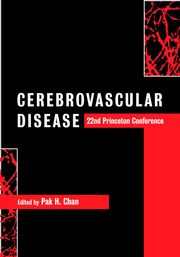Book contents
- Frontmatter
- Contents
- List of contributors
- Preface
- Acknowledgments
- Part I Special lectures
- Part II Oxidative stress
- Part III Apoptosis
- 7 Cell death programs in neural development and disease
- 8 Apoptotic gene expression in brain ischemia and ischemic tolerance
- 9 Cellular mechanisms of white matter ischemia: what can we learn from culture models?
- Part IV Hot topics
- Part V Hemorrhage, edema and secondary injury
- Part VI Inflammation
- Part VII Gene transfer and therapy
- Part VIII Neurogenesis and plasticity
- Part IX Magnetic resonance imaging in clinical stroke
- Part X Risk factors, clinical trials and new therapeutic horizons
- Index
- Plate section
8 - Apoptotic gene expression in brain ischemia and ischemic tolerance
from Part III - Apoptosis
Published online by Cambridge University Press: 02 November 2009
- Frontmatter
- Contents
- List of contributors
- Preface
- Acknowledgments
- Part I Special lectures
- Part II Oxidative stress
- Part III Apoptosis
- 7 Cell death programs in neural development and disease
- 8 Apoptotic gene expression in brain ischemia and ischemic tolerance
- 9 Cellular mechanisms of white matter ischemia: what can we learn from culture models?
- Part IV Hot topics
- Part V Hemorrhage, edema and secondary injury
- Part VI Inflammation
- Part VII Gene transfer and therapy
- Part VIII Neurogenesis and plasticity
- Part IX Magnetic resonance imaging in clinical stroke
- Part X Risk factors, clinical trials and new therapeutic horizons
- Index
- Plate section
Summary
Introduction
It is now clear that the process of apoptotic cell death plays a major role in the outcome of acute ischemic injury in the brain, and there is evidence that these gene families may play a role in the phenomenon of ischemic tolerance as well. These genes and their translated proteins are widely distributed throughout the body and diffusely represented in the brain. Thus, while their overall death modulatory role is known, precisely what the activity of a particular apoptotic or anti-apoptotic gene product might be in a particular cell type in a specific paradigm of ischemia is not clear, clouding the pathway to therapeutic translation. A few of these central issues are reviewed below.
Anti-apoptotic gene expression in ischemia and tolerance are not cell-type specific
These features are clearly demonstrated in focal ischemia. Using the intraluminal suture method, one can produce ischemic infarction in the caudate putamen while producing a penumbral effect in the cortex. In such a situation there is widespread induction of the prosurvival gene product, Bcl-2. However, expression in the penumbral cortex is almost entirely neuronal, while in the ventral-cortical regions close to the ischemic core, the predominant cell type expressing Bcl-2 is astroglial. Bcl-2 is expressed in the infarct core as well where neither neurons nor glia survive. The cells expressing Bcl-2 there are the endothelial cells of the surviving blood vessels (Figure 8.1).
- Type
- Chapter
- Information
- Cerebrovascular Disease22nd Princeton Conference, pp. 87 - 94Publisher: Cambridge University PressPrint publication year: 2002



